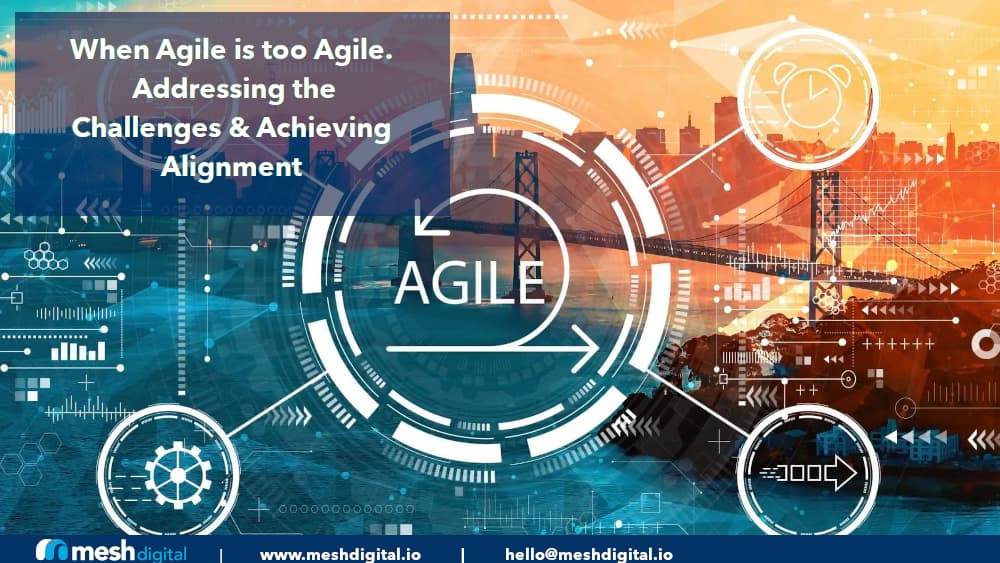When Agile is Too Agile: Addressing Challenges and Achieving Organizational Alignment in the Enterprise
Agile practices can lead to challenges, particularly when projects involve complex dependencies and require alignment across the organization. This article explores the issues that arise when Agile is "too agile" for an enterprise and offers strategies to address these challenges.

Introduction
The Agile methodology has undoubtedly gained significant popularity in recent years due to its ability to enhance flexibility, responsiveness, and productivity in everything from software development to project management, to agile funding models. However, for larger enterprises, adopting Agile practices can lead to challenges, particularly when projects involve complex dependencies and require alignment across the organization. The Spotify model, while successful for some, may not provide the level of structure needed to manage dependencies effectively. This article explores the issues that arise when Agile is "too agile" for an enterprise and offers strategies to address these challenges, achieving alignment and success in Agile adoption.
The Agile Paradox for Enterprises
Agile is founded on the principles of flexibility and adaptability, allowing teams to respond quickly to changing requirements. However, for large enterprises with multiple projects, teams, and stakeholders, excessive agility can lead to unintended consequences:
a. Lack of Structure & Alignment: The lack of defined processes and standardized practices can lead to inconsistent outcomes across teams and projects. Without proper alignment, dependencies between teams, and projects become challenging to manage.
b. Resource Allocation Issues: When Agile teams work independently, resource allocation becomes complex. There may be a lack of visibility into resource availability and allocation, and funding leading to inefficiencies and bottlenecks.
c. Risk of Duplication and Redundancy: Without sufficient coordination, different teams may unknowingly work on similar projects, resulting in duplicated efforts and wasted resources.
d. Difficulty in Scaling: Rapidly scaling Agile across an enterprise may not be sustainable without the necessary governance and coordination mechanisms in place.
The Limitations of the Spotify & Similar Models
The Spotify model, which gained attention for its success in scaling Agile at Spotify, emphasizes autonomy, cross-functional teams, and a decentralized structure. All great things, for many organizations! While it can work well for certain firms, due to several key characteristics it may not be the ideal fit for all enterprises as we’ll explore below:
a. Lack of Formal Planning Mechanisms: The Spotify model doesn't explicitly provide a structured approach for enterprise-level planning and dependency management. This can lead to difficulties in coordinating complex projects and aligning cross-functional efforts. Even leveraging a similar model with Scrum@Scale and its Big Room planning sessions most firms find it challenging to create the needed alignment and workload deduplication.
b. Dependencies and Silos: As the number of teams increases, dependencies between them may become difficult to manage, leading to siloed efforts and a lack of shared objectives. The bigger the organization, the more challenging this becomes. Even corporate culture becomes a bottleneck here, fracturing further the firm, many times reinforcing corporate fiefdoms.
c. Scalability Challenges: As the organization grows, the Spotify model's decentralized structure may face challenges in maintaining consistent practices and alignment across all teams.
Balancing Agility & Structure: Strategies for Enterprise Adoption
a. Establish a Clear Governance Framework: An effective governance framework should provide guidelines for decision-making, resource allocation, and risk management. It ensures alignment between teams and projects without stifling creativity and agility.
b. Implement SAFe or Similar Frameworks: Scaled Agile Framework (SAFe) provides a structured approach to scaling Agile in enterprises. By adopting SAFe or similar frameworks, organizations can introduce the necessary structure to manage dependencies and coordinate efforts.
c. Foster Collaboration and Communication: Encourage open communication and collaboration between teams to enhance understanding, reduce duplication, and facilitate cross-team alignment.
d. Align with Business Objectives: Link Agile initiatives to strategic business objectives, ensuring that Agile practices align with the overall goals of the enterprise.
e. Invest in Training and Support: Providing comprehensive training and ongoing support for Agile adoption helps teams understand the methodology, its benefits, and how to navigate challenges effectively.
Embracing Agile Customization
Rather than strictly adhering to a specific Agile model, consider tailoring Agile practices to suit the unique needs of the enterprise:
a. Hybrid Approach: Adopt a hybrid Agile approach that combines elements of various methodologies, such as Scrum and Kanban, to accommodate the organization's requirements.
b. Customize Agile Ceremonies: Adapt Agile ceremonies, such as daily stand-ups and retrospectives, to align with the organization's context and foster better coordination.
c. Agile Coaches & Mentors: Leverage Agile coaches and mentors to guide teams in adopting Agile practices and overcoming implementation challenges.
Continuous Improvement and Feedback
Don’t forget that continuous improvement is at the heart of Agile methodologies. Encourage teams to embrace retrospectives and feedback loops, allowing them to identify areas of improvement and iteratively enhance their Agile practices.
Conclusion
While Agile methodologies have proven successful in numerous contexts, adopting Agile at the enterprise level requires a thoughtful approach. The Spotify model, while inspiring, may not provide the level of structure needed to manage dependencies and achieve alignment across the organization. Striking the right balance between agility and structure is crucial for larger enterprises seeking to harness the benefits of Agile practices.
By establishing a clear governance framework, implementing appropriate scaling frameworks, and fostering collaboration, enterprises can address the challenges of "too much agility." Customizing Agile practices to suit the organization's needs and embracing continuous improvement ensure that Agile adoption is successful and aligned with strategic business objectives.
References:
- Leffingwell, D. (2019). Scaled Agile Framework® for Lean Enterprises: SAFe® 4.6 Distilled. Addison-Wesley Professional.
- Régny, R., & Stańczyk, D. (2020). Customizing Agile Practices for Large Organizations. IEEE Software, 37(2), 36-41.
- Sutherland, J. (2014). Scrum: The Art of Doing Twice the Work in Half the Time. Crown Business.
- Teasley, G. E., & Fisher, D. M. (2019). Scaling Agile Across the Enterprise: A Management Approach. Cutter Business Technology Journal, 32(3), 14-23.
- White, A., & King, M. (2017). Agile Adoption in Large Organizations: A Systematic Literature Review. Information and Software Technology, 91, 73-87.
